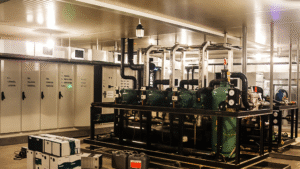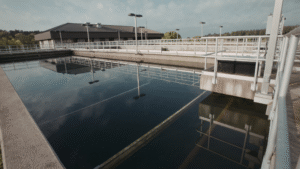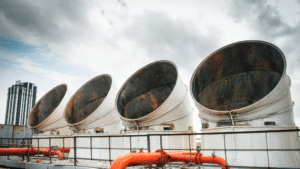Without the right chemical water treatment in industrial cooling systems, scale accumulates rapidly, corrosion aggressively degrades metal surfaces, and biofilm growth restricts efficiency—leading directly to soaring energy costs and potential equipment failures. Yet, these risks are entirely preventable with expertly formulated chemical programs.
While ETI does not specialize in water treatment, we have over three decades of experience mastering the chemistry behind it. This guide introduces our four highly effective chemical treatment programs for cooling water management, specifically crafted to prevent scaling, halt corrosion, and proactively eliminate microbial threats in your cooling tower systems.
Key Takeaways
- Proper chemical wastewater treatment prevents scaling, corrosion, and biofouling—ensuring maximum cooling tower efficiency and longevity.
- ETI’s custom-blended solutions optimize water chemistry, reduce maintenance costs, and improve heat transfer performance.
- Integrating biocides, corrosion inhibitors, scale inhibitors, and dispersants is essential for sustained cooling system reliability.
Importance of Cooling Tower Chemical Treatment Programs
Cooling towers are integral components for expelling heat across a multitude of industries, including power production and various commercial entities. These pivotal elements within boiler and cooling systems ensure that temperatures remain conducive to both industrial processes and machinery function. Yet, the efficiency and durability of these systems hinge critically on the circulating water’s quality. Lacking proper water treatment and appropriate chemical management, cooling towers may encounter severe problems such as scaling, corrosion, and biofouling—each potentially causing substantial operational inefficiencies along with expensive repair needs or complete halts in operation.
The phenomenon known as scaling arises when minerals dissolved in water crystallize into tough deposits on surfaces designated for heat transfer. This calcification can drastically diminish a tower’s capacity to shed heat effectively while simultaneously elevating energy demands alongside other operating costs and expenses. Alternatively, corrosion wreaks havoc upon metallic surfaces leading to leaks or structural failure necessitating costly remediation or replacement efforts. The presence of harmful microorganisms when treating wastewater like bacteria and algae results in biological fouling which poses risks by obstructing piping systems diminishing flow rates thus amplifying pre-existing complications related to scale formation and corrosive damage, as well as potential emergence of legionella.
The role played by well-designed chemical processes, water treatment systems and strategies aimed at preserving cooling towers is absolutely critical. They help maintain performance levels high while ensuring reliable operations. By partnering with a best-in-class chemical blender and initiating robust regimes centered around the proper selection and use of chemicals, you can support your clients with uninterrupted productivity across various industries.
Understanding Cooling Water Chemistry
Effective cooling tower management starts with understanding key water chemistry parameters:
- pH Control – The ideal range (6.5–7.5) minimizes scale and corrosion risks. Some treatment programs allow for slightly higher pH levels.
- Alkalinity – Helps stabilize pH and buffer acids. Controlled alkalinity prevents fluctuations that lead to inefficiencies.
- Water Hardness – High calcium and magnesium levels cause scaling, reducing heat transfer efficiency and increasing operational costs.
- Conductivity – Measures dissolved mineral concentration. Regular monitoring prevents excessive scale buildup and optimizes blowdown rates.
- Cycles of Concentration – The ratio of dissolved solids in recirculating water vs. fresh makeup water. Higher cycles save water but require careful chemical management.
By closely monitoring these factors and applying the right chemical treatment strategies, operators can prevent performance issues and ensure long-term reliability.
Key Components of Effective Chemical Treatment Programs
Biocides for Microbial Control
Biocides eliminate bacteria, algae, and fungi that form biofilms and contribute to microbiologically influenced corrosion (MIC). ETI provides both oxidizing and non-oxidizing biocides, ensuring comprehensive microbial control:
- Oxidizing Biocides – Chlorine, bromine, and chlorine dioxide destroy microbes through oxidation, preventing biofilm formation.
- Non-Oxidizing Biocides – Organic-based solutions like isothiazolones, quats, and glutaraldehyde disrupt microbial cell function without oxidation.
- Biofilm Penetrants & Surfactants – Enhance biocide effectiveness by breaking up biofilms for deeper penetration.
Corrosion Inhibitors for Metal Protection
Corrosion inhibitors create a protective film on metal surfaces, preventing damage from oxygen, water, and contaminants. Without them, cooling system components deteriorate rapidly, leading to leaks, downtime, and expensive repairs.
- Phosphate-Based Inhibitors – Form a stable phosphate film to protect mild steel.
- Silicate-Based Inhibitors – Prevent pitting and corrosion on aluminum surfaces.
- Organic Inhibitors – Azoles (e.g., benzotriazole) protect copper, while amine-based inhibitors shield ferrous metals.
Scale Inhibitors to Prevent Mineral Deposition
Scale inhibitors interfere with mineral crystallization, preventing deposits that reduce heat transfer and increase energy costs.
- Scale Control Agents – Keep minerals dissolved, reducing scaling risks.
- Dispersants – Prevent suspended solids from settling and forming deposits.
- Customized Formulations – Tailored to site-specific water conditions for maximum performance.
Biofilm Control & Dispersants
- Biofilm Control Agents – Disrupt microbial colonies that lead to biofouling and MIC.
- Dispersants – Prevent particle accumulation, ensuring water clarity and efficient system flow.
- Advanced Monitoring (HMB X System) – ETI’s predictive biofilm monitoring tool detects microbial activity early, optimizing treatment plans.
Top 4 Chemical Treatment Programs for Cooling Towers
Chemical water treatment solutions and programs for cooling towers are vital in enhancing their efficiency by managing scale, corrosion, and biological growth. Such wastewater treatment programs are tailored to meet the particular challenges that cooling water systems encounter to maintain optimal functionality. These includes:
1. Biocide-Based Treatment
Effective biocide treatment programs are essential for controlling biological growth in cooling water systems and industrial wastewater, ensuring both operational efficiency and regulatory compliance. Without proper microbial control, bacteria, algae, and fungi can proliferate, leading to biofilm formation, which clogs piping, reduces heat transfer efficiency, and accelerates microbiologically influenced corrosion (MIC).
Reputable companies like ETI have built strong relationships with leading microbiocide manufacturers, earning a trusted distributor role for a wide range of biocide chemistries. With over 35 biocide formulations, including liquid and solid bromine products, under manufacturer’s labels and private labels for qualified water treatment service companies to enhance biocide efficacy. ETI also provides biopenetrants and surfactants, which improve biofilm disruption and penetration, ensuring more cost-effective microbial control.
ETI Biocide Offerings
Oxidizing Biocides: Bromine-Based Solutions
- BCDMH Tablets – Bromicide Tablets BCDMH (96% BCDMH, 1-inch Tablet) (56% as Cl₂).
- BCDMH/CCDMH Blend – Dantobrom RW (98% BCDMH/CCDMH blend, Briquettes) (62% as Cl₂).
- Liquid Stabilized Bromine – STABROM® 909 (O&G applications available, 6.9% as Cl₂).
- Liquid Stabilized Bromine – STABROM® Plus (8.0% as Cl₂).
- Bromo/Chloro Isocyanurate – TowerBrom®60M (57% as Cl₂, Granular) & TowerBrom®90M (83% as Cl₂, Tablet).
- Liquid Sodium Bromide – Sanibrom® 40 (40% NaBr Liquid Solution).
Oxidizing Biocides: Chlorine-Based Solutions
- Chlorinated Isocyanurate – ACL®56 Disinfecting Granules (56% as Cl₂, Granular).
- Chlorine Tablets – TowerChlor®90 (90% as Cl₂, Tablet).
- Sodium Hypochlorite – 12.5% Sodium Hypochlorite Solution (available in DE, IN, MD, NC, NJ, NY, PA, & VA).
Non-Oxidizing Biocides
- Isothiazolin & Iso/Bronopol Blend – Preventol D7 CF (1.5% Iso) & Preventol P-91 (10.0% BNPD/1.1% Iso).
- Isothiazolin/Surfactant Blend – Kathon 725BF (1.5% Iso/Surf).
- Liquid Stabilized Peroxide-Quat Blend – Ultra-Kleen™ Solution 1 (6% Peroxide – 6% ADBAC Quat).
- Dodedecylguanidine Hydrochloride (DGH) – N-2000 (35%) (O&G applications available).
- DBNPA Liquid – Aqucar™ DB 5 (5%) & Aqucar™ DB 20 (20%).
- DBNPA Solid – Envirobrom Tabs (96%).
- Glutaraldehyde – Aqucar™ GA 4PO (4%), GA 15 (15%), GA 45 (45%) & GA 50 (50%).
- Glutaraldehyde & ADBAC Quat Blend – Aqucar™ 714 (14%) & Aqucar™ 742 (42%).
- Bronopol (BNPD) Solid – 2K7 Bug Stick (85%) & 2K7 Water Soluble Pack (98%) (O&G applications available).
- THPS (Tetrakis Hydroxymethyl Phosphonium Sulfate) – Tolcide® PS20A, PS50A & PS70A (20%, 50%, and 70% active w/ biodispersant) (O&G applications available).
- WSCP/PolyQuat Dispersants – Mayosperse 7700-15 (15%), 7700-30 (30%) WSCP, & 7700-60 (60%).
2. Corrosion Inhibitor Regimen
To protect metal components in cooling towers from premature degradation, corrosion inhibitors play a critical role in forming a protective barrier on surfaces, significantly reducing metal deterioration. Without these protective treatments, cooling system components are vulnerable to accelerated corrosion, leading to leaks, structural damage, and costly repairs. A well-maintained corrosion inhibitor program is essential for preserving the longevity and efficiency of the entire cooling system.
VpCI Technology for System Lay-Up Protection
Beyond active cooling operations of boiler systems, ETI also provides Vapor phase Corrosion Inhibitor (VpCI) technology to protect idle boilers, cooling water systems, and related equipment during lay-up periods. VpCIs function by vaporizing into the airspace of a system, forming a molecular protective film on all metal surfaces—both exposed and submerged.
This Cortec®-based technology is ideal for:
- Dry lay-up – When equipment is drained for extended periods.
- Partially wet or flooded lay-up – When some water remains in the system.
Properly applied, VpCI solutions can provide corrosion protection for up to two years, ensuring that equipment remains in optimal condition until it is brought back online. Whether a boiler, cooling system, or auxiliary equipment is non-operational, drained, or partially flooded, VpCI technology is an excellent choice for preventing corrosion damage during downtime.
3. Scale Prevention Strategy
While chemical scale inhibitors effectively manage scaling inside cooling towers, optimizing makeup water quality before it enters the system can further enhance performance. Membrane treatment—such as Reverse Osmosis (RO), Nanofiltration (NF), and Ultrafiltration (UF) through our partner companies—removes dissolved solids, other organic compounds, contaminants, and microbial impurities from hard water, significantly reducing scaling potential, biofouling, and corrosion risks.
ETI takes cooling tower water management a step further by offering:
- ANSI/NSF Standard 60-approved antiscalants for membrane protection.
- US-EPA approved biocides for non-potable membrane systems.
- Specialized membrane cleaners to restore performance when fouling occurs.
- Technical support and lab services to optimize system design and water treatment plans.
By integrating membrane cleaning and pretreatment with cooling tower chemistry, operators can achieve higher cycles of concentration, lower blowdown rates, and reduced reliance on aggressive chemical treatments. This results in better system performance, extended equipment life, and improved sustainability.
4. Biofilm Control Protocol
Effective biofilm control is important for maintaining cooling water quality and system efficiency, as biofilms create protective layers that shield microorganisms from disinfectants and pollutants, making them difficult to eliminate. These microbial colonies adhere to surfaces within the cooling system, accelerating scaling, promoting microbiologically influenced corrosion (MIC), and reducing heat transfer efficiency. Left unmanaged, biofilms increase maintenance costs, energy consumption, and the risk of equipment failure.
ETI enhances biofilm management by offering the HMB X System, a fully outfitted test kit for predictive monitoring of biofilm activity in cooling water and other water-based systems. The HMB X System utilizes a special biofilm coupon that mounts in any corrosion coupon rack, providing an indirect measurement of surface microbial activity. It can also be used to monitor bulk water bacteria, delivering rapid, on-site results in just 15 minutes.
With the HMB X System, operators can:
✔ Detect biofilm activity early, allowing for more proactive treatment adjustments.
✔ Monitor both surface and bulk water bacteria, ensuring comprehensive microbial control.
✔ Optimize biocide dosing strategies, reducing overuse and improving efficiency.
Benefits of Proper Chemical Treatment
Effective chemical treatment plans are crucial in significantly extending the service life of cooling tower machinery by protecting against corrosion and scale formation. By implementing these chemical treatments correctly, there’s a decrease in the need for equipment replacement, thus prolonging the lifespan of the entire cooling system infrastructure. The financial benefits include reduced capital expenditure as well as fewer instances of downtime and disruption to operations.
In essence, appropriate application of chemical treatments contributes to:
- Prolonged durability of equipment
- Diminished running costs
- Enhanced proficiency in heat transfer
- Effective suppression of biological contamination
Given these considerable upsides, integrating robust programs for administering chemical treatments becomes an indispensable aspect when overseeing coolant towers’ functionality – a crucial process in ensuring their smooth operation with high reliability.
Optimize Your Cooling Tower Performance with ETI’s Chemical Blending Expertise
For over 3 decades, ETI has been the trusted partner in industrial water treatment, delivering custom-blended chemical solutions and water technologies that optimize cooling tower performance, efficiency, and longevity.
- Custom Chemical Blending
- Comprehensive Cooling Tower Chemistry
- Regulatory Compliance Support
- Expert Technical Support
Take your cooling tower and water treatment plants to the next level with ETI’s proven chemical expertise. Contact ETI now or request a consultation at support@go2eti.com.
Frequently Asked Questions
What are the main issues if cooling towers are not properly treated?
Improperly treated cooling towers face issues like scaling, corrosion, and fouling, which can diminish efficiency, escalate energy costs, and result in expensive repairs.
It’s crucial to maintain proper treatment to avoid these costly consequences.
Why is monitoring water chemistry important?
Monitoring water chemistry is essential for odor control, preventing scale and corrosion, helping to maintain optimal conditions and protect equipment integrity.
Regular checks of parameters such as pH, alkalinity, and conductivity are key to effective water management.
What are the benefits of using green chemical alternatives?
Using green chemical alternatives significantly lowers environmental impact and enhances safety for both users, environment and ecosystems.
They also promote sustainability and ensure compliance with increasing regulatory standards.
How often should chemical treatments be adjusted for seasonal changes?
Chemical treatments should be adjusted regularly to align with seasonal changes, as these can greatly affect cooling tower performance.
Regular reviews and modifications of treatment protocols are essential for maintaining optimal water quality and maintaining system efficiency throughout.
What training is available for water technologists?
Water technologists can enhance their skills through programs like the ETI Bootcamp and CWT Certification, which cover essential topics certified water technologists such as water chemistry, water treatment processes and technologies, and safety procedures.
These training opportunities equip professionals to effectively manage complex cooling water systems in industrial applications.





